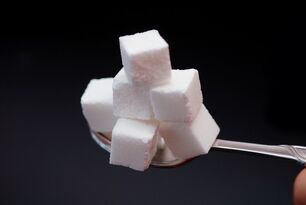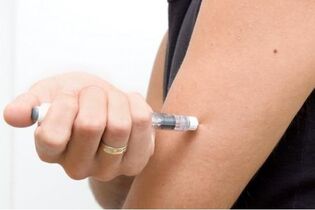
Diabetes is a chronic disease characterized by metabolic disorders due to absolute or relative insulin deficiency. The pancreas is the only organ that weighs 70 to 100 grams and is located in the abdominal cavity of the duodenum. Plays a key role in the digestion of proteins, fats and carbohydrates. It also produces insulin, which regulates the metabolism of carbohydrates in the body. In this article, we will talk about what to eat in diabetes.
Types of Diabetes
Doctors distinguish several types of diabetes depending on the cause and course of the disease:
- Type I diabetes, insulin dependent;
- Type II diabetes usually develops later, especially in obese patients.
Type I diabetes usually results from damage to the pancreas. In other words, the main disorder of beta cells (insulin-producing substances in the pancreas) and the absolute lack of insulin secretion.
Early symptoms of type I diabetes include severe thirst, hunger, unexplained weight loss, excessive urination, blurred vision, fatigue, and chronic infections. In some cases, the onset is accompanied by convulsions, confusion, slurred speech, and loss of consciousness. Type I diabetes is considered an immunological disease.
Type II diabetes is more common in obese people. The disease can be congenital or transmitted to the heart, and is characterized by decreased insulin secretion by the pancreas, as well as insulin resistance. Therefore, the required amount of insulin in the body cannot perform the task.
The disease is accompanied by excessive thirst and frequent urination, which gradually raises blood sugar levels. The patient feels weak and sleepy. The disease usually begins in middle-aged and elderly people. However, in recent years the number of young patients with type II diabetes has increased dramatically. The number of children and adolescents in this situation is too high and overweight.
What is hyperglycemia

Hyperglycemia is a high blood glucose level. Symptoms of hyperglycemia include thirst, dry mouth, frequent urination, weight loss, and excessive daytime sleepiness.
The most common cause of hyperglycemia is undiagnosed or poorly controlled diabetes. In people with diabetes, this condition can be caused by a lack of insulin.
Hyperglycemia is the result of infectious and endocrine diseases (acromegaly, Cushing's syndrome). The risk of late complications is particularly high in the cardiovascular system.
Chronic hyperglycemia is associated with dysfunction and failure of various organs - the eyes, kidneys, nerves, heart and blood vessels.
Proper nutrition for diabetes
Diet is the most important part of diabetes prevention. Optimal blood glucose and lipid levels and blood pressure should be maintained. Properly selected diet reduces the risk of complications of diabetes and minimizes the risk of cardiovascular disease. Diabetes-related diet plays an important role in the prevention and treatment of chronic complications of diabetes. Including microvascular complications, retinopathy, nephropathy, diabetic neuropathy and others.
Eating diabetes is one of the main factors influencing the outcome of diabetes.
Sugar is very important for life, but in this case it is better to remove the sugar bowl! Diabetes mainly affects the metabolism of carbohydrates. People diagnosed with diabetes should limit their intake of sugar or carbohydrates.

Sugar:
- monosaccharides - glucose and fructose are found in fruits and honey;
- sucrose disaccharide - sugar from a container of sugar;
- Polysaccharides - flour products, pastries, cookies and bread, potatoes, bananas, noodles, dumplings, pasta, pancakes and more.
Carbohydrates for Diabetes
Carbohydrates are part of our diet. Their consumption should cover 55-60% of the total demand. Much depends on the shape and structure of carbohydrates. Carbohydrates in the gastrointestinal tract are absorbed and broken down into simple sugars - mainly glucose.
Note that excess carbohydrates cause the pancreatic beta cells to secrete insulin on a regular basis.
As sugar levels rise, our pancreas secretes insulin. Insulin is a hormone that allows glucose to enter cells. Simple sugar, like glucose, is delivered to the cells quickly within an hour.
Unfortunately, insulin is a hormone that lasts for several hours and does not like to be "unemployed". Thus, an increase in insulin levels causes changes in blood glucose and carbohydrate starvation.
A hungry person opens a cold and begins to eat to satisfy this hunger. The adrenal glands receive information: the fluctuations of blood glucose. All of these reactions are signals that the adrenal glands secrete adrenaline. This creates a vicious cycle that leads to stress, depression and autonomic neurosis (neurasthenia).
Therefore, it is recommended to reduce carbohydrates to a minimum. In this situation, there is no change in blood glucose levels and no overproduction of the hormones insulin and adrenaline.

Glucose passes through the walls of the digestive tract, enters the bloodstream and enters various organs, where it is converted into a source of energy. When you don't get enough exercise, your energy needs decrease, and glucose is stored as glycogen in your muscles and liver.
When in excess, glycogen is converted into fat, which leads to fatty liver, as well as further accumulation of excess fat in the body. The metabolism of glucose is controlled by the hormone insulin, which is produced in the pancreas.
Carbohydrates, the main source of energy, can enter the cell only with the help of insulin, which distributes simple sugars. However, for example, insulin deficiency causes an increase in blood sugar levels, followed by severe cellular metabolism. Total insulin deficiency leads to diabetes in children and adolescents - type I diabetes.
Protein in Diabetes
Protein should cover 10-15% of energy needs. Growing children and pregnant women need more. The most valuable are animal protein in lean meat, cheese, eggs and sour milk.
Since our body can produce 56 g of sugar per 100 g of protein, it is even more important to limit protein intake. To avoid harm to the body, it is necessary to eat high quality protein (yolk, meat intestine). Sources of vegetable protein are soy, beans, rye flour, and rye bread.
Diet and not to do due to diabetes
The first step in treating diabetes is to include foods such as egg yolks, butter, cream, milk, and unsweetened vegetables.
During this time, you should significantly reduce your diet: egg whites, lean meats, fish, poultry and nuts.
People with diabetes should not eat too much food or protein in the evening. At night, the body cannot use it. Because the pancreas does not produce enough insulin, blood glucose levels rise in the morning. In this case, a dinner consisting mainly of carbohydrates and fats is recommended.
Fats contain the most energy. They can cover only 30% of daily energy consumption. In addition, they contribute to the development of obesity.
Spices such as cinnamon, garlic, cloves, turmeric and bay leaf lower cholesterol and blood glucose levels.
Can Diabetics Eat Fruits and Vegetables? Yes, because they are a rich source of vitamins and minerals. Fresh vegetables, including broccoli, are ideal for diabetics as an excellent source of chromium. Onions that work to release insulin. Potatoes (boiled potatoes quickly raise blood sugar), asparagus, raw carrots, fresh cucumbers, sauerkraut, fruit leaves and stem tea, garlic.

You can eat vegetables without significant restrictions:
- tomato;
- fresh and pickled cucumbers;
- raw and pickled cabbage;
- chicory;
- kohlrabi;
- radish;
- paprika;
- salad
- mushrooms;
- zucchini.
The best remedy for diabetes is fresh green leaves harvested before the fruit ripens. Blueberries can prevent diabetic retinopathy - Studies have shown that people suffering from eye diseases improve their vision during diabetes. This disease causes changes in the depths of the eye, which significantly worsens the blood circulation in the eye.
Diabetics who are overweight (BMI over 25) are advised to limit calories to lose weight.
Food Glycemic Index
Blood glucose is affected not only by the amount of carbohydrates, but also by their type. Therefore, it is necessary to control the amount and quality of carbohydrates in food, but it is also better to calculate the glycemic index of the product.
Foods at GI levels are slow to digest and digest, do not raise blood glucose quickly, and do not stimulate the release of insulin. A low GI diet reduces the risk of developing insulin-dependent diabetes.
The higher the GI value of a food, the higher the blood glucose level after eating that food. Foods that raise GI levels are similar to blood glucose. The slow absorption of GI after eating small meals and the gradual increase and decrease in blood sugar help to control sugar levels in diabetes. It is best to eat foods that do not exceed 60 GI.
In the natural form of food GI, p. a. When used raw and unprocessed, it is significantly lower.
For diabetics, it is recommended to abstain from alcohol.














































































